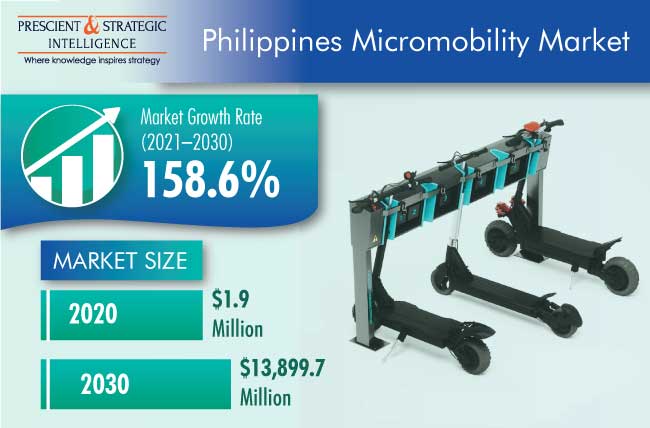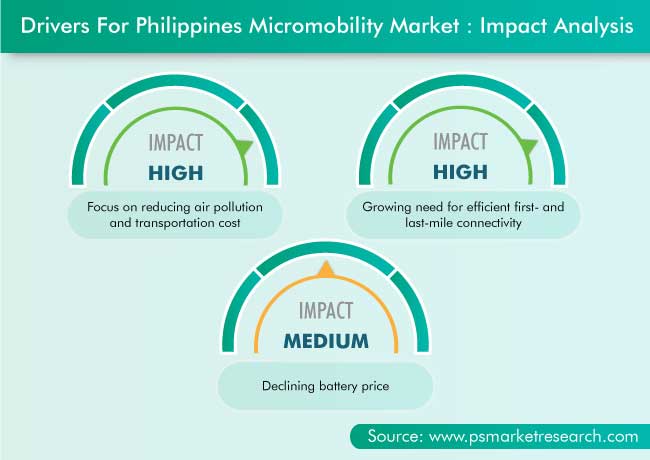Report Code: 12252 | Available Format: PDF | Pages: 94
Philippines Micromobility Market Research Report: By Type (E-scooters, E-bikes, E-mopeds, E-pods, Bikes, Scooters), Model (First- and Last-Mile, Multimodal), Sharing System (Docked, Dockless) - Industry Analysis and Growth Forecast to 2030
- Report Code: 12252
- Available Format: PDF
- Pages: 94
- Report Description
- Table of Contents
- Market Segmentation
- Request Free Sample
Market Overview
The Philippines micromobility market was valued at $1.9 million in 2020, and it is expected to grow at a CAGR of 158.6% during the forecasted period (2021–2030). The major factors driving the growth of the market include the increasing need for reducing air pollution and transportation cost, proliferating demand for efficient micromobility services for first- and last- mile connectivity, and declining battery price.
The COVID-19 pandemic impacted almost all industries, including micromobility, in 2020. However, with proper control measures pertaining to the monitoring of the COVID-19 impact, contingency planning, tightening of financial steering, and diligent staff engagement, along with consumer demand creation, the situation is projected to normalize soon. Moreover, since the end of 2020, the COVID-19 has boosted the development of bike culture in the country, as this pandemic has stimulated several opportunities for micromobility service providers. The consumers, who want to engage in leisurely outdoor activities while practicing safe and physical distancing to minimize the spread of COVID-19, are inclining more toward the adoption of micromobility services. Thus, the pandemic has boosted the popularity of first- and last-mile solutions among the people, which, in turn, has a positive impact on the Philippines micromobility market growth. Moreover, companies are also focusing on regularly disinfecting and sanitizing their fleet, to achieve a huge customer base.

E-Mopeds Dominated the Market during Historical Period, Due to their Economical Nature
The e-mopeds category accounted for the largest value share in 2020 in the Philippines micromobility market, based on vehicle type. This category is also expected to grow at the highest growth rate during the forecast period. This growth can be majorly attributed to the surging use of e-moped services due to their economical in nature.
Dockless Category To Witness Faster Growth, Due to High Users Preference
The dockless category accounted for larger share in 2020 in the Philippines micromobility market, and it is further expected to grow at a higher CAGR during the forecast period, on the basis of sharing system. This can be attributed to the fact that several mobility service providers are focused on offering dockless sharing system, due to the high user’s preference and less parking effort requirement in renting dockless system.
Adoption of Battery Swapping Technology for Charging Micromobility Fleet Is a Key Market Trend
The introduction of swappable batteries has increased the fleet uptime substantially, while also reducing the operational cost, which has ultimately taken the micromobility industry in the Philippines toward profitability. Additionally, with the use of swappable batteries, the revenue generation of the e-scooter business can be improved, as these batteries not only cut a large part of the charging costs, but also improve the vehicle availability. Furthermore, various electric two-wheeler manufacturers are also focusing on installing battery swapping stations for public and commercial use. For instance, in February 2019, Honda Motor Co. Ltd., Komaihaltec Inc., and Romblon Electric Cooperative Inc. (ROMELCO) together launched a demonstration project with an aim to generate electricity with wind energy in Romblon Island, the Philippines.

Focus on Reducing Air Pollution and Transportation Cost Is Driving the Market Growth
The growth of the micromobility ecosystem has been exponential in the country, due to factors such as high availability, low pricing, and ease of functioning. The growth in adoption rate of micromobility services has been 10 times higher as compared to the growth of the ride sharing market in its initial phase. This is mainly due to the low-cost travel option offered by micromobility service, which has lured commuters to try the service for the first time. Along with cost saving, micromobility can also save time of travel, due to its compact and swift nature. Further, the national government authorities have also identified micromobility as a replacement to intra-city congestions during peak traffic hours, which, in turn, has a positive impact on the Philippines micromobility market.
Declining Battery Price Is Propelling the Market
Reducing cost of batteries is resulting in decreasing the upfront cost of electric personal mobility device (PMD), helping in increasing sales and adoptions of these vehicles for micromobility services. Presently, one-third of the cost of an electric vehicle is operated by the battery, whose cost is expected to continue falling during the forecast period. Furthermore, micromobility players are adopting new age lithium-ion batteries, as these batteries are eco-friendlier, offering reduced charging time and increased running economy than lead–acid batteries. The government is also supporting lithium-ion battery companies by offering incentives and tax credits. Therefore, declining prices of lithium-ion batteries would continue to support the micromobility market in the Philippines in coming years.
| Report Attribute | Details |
Historical Years |
2019-2020 |
Forecast Years |
2021-2030 |
Base Year (2020) Market Size |
$1.9 Million |
Market Size Forecast in 2030 |
$13,899.7 Million |
Forecast Period CAGR |
158.6% |
Report Coverage |
Market Trends, Drivers, and Restraints, Revenue Estimation and Forecast, Segmentation Analysis, Impact of COVID-19, Companies’ Strategic Developments, Company Profiling |
Market Size by Segments |
By Vehicle Type, By Model, By Sharing System |
Secondary Sources and References (Partial List) |
Alternative Fuels Data Center (AFDC), Electric Drive Transportation Association (EDTA), Electric Vehicle Association of Asia Pacific (EVAAP), International Energy Agency (IEA), International Kicksled and Scooter Association (IKSA), International Scooter Association (ISA), Light Electric Vehicle Association (LEVA), Mobility as a Service Alliance (MaaS Alliance) |
Explore more about this report - Request free sample
Market Players Involved in Service Expansion to Gain Significant Position
In recent years, the players operating in the Philippines micromobility industry have been involved in service expansion in order to attain a key position in the market. For instance:
- In December 2020, Moovr PH launched its bike and e-scooter sharing services in Bonifacio Global City (BGC), the Philippines, with a fleet of 200 single-speed bikes, 20 Segway Ninebot Pro Max e-scooters, and 14 hubs. Users have to pay $0.3 (Php 15) for the first 15 minutes or $1.3 (Php 60) per hour to rent a bike and $1.1 (Php 50) for 20 minutes or $3.2 (Php 150) per hour to rent an e-scooter.
Key Players in Philippines Micromobility Market Include:
-
Grab Holdings Inc.
-
Giant Manufacturing Co. Ltd.
-
Merida & Centurion Germany GmbH
-
Moovr PH
-
Ningbo Kaabo Technology Co. Ltd.
-
StreetWheels Philippines
-
Niu Technologies
-
Ningbo MYWAY Intelligent Technology Co. Ltd.
-
Kwang Yang Motor Co. Ltd.
-
Segway Inc.
-
Vmoto Limited
Market Size Breakdown by Segments
The Philippines micromobility market report offers comprehensive market segmentation analysis along with market estimation for the period 2019-2030.
Based on Type
- E-scooters
- E-bikes
- E-mopeds
- E-pods
- Bikes
- Scooters
Based on Model
- First- and Last-Mile
- Multimodal
Based on Sharing System
- Docked
- Dockless
In 2030, the value of the Philippines micromobility market will be $13,899.7 million.
The Philippines micromobility market is expected to grow at a CAGR of 158.6% during the forecast period (2021–2030).
E-mopeds are the largest category under the vehicle type segment of the Philippines micromobility industry.
The major Philippines micromobility market drivers include the increasing need for reducing air pollution and transportation cost, proliferating demand for efficient micromobility services for first- and last- mile connectivity, and declining battery price.
Most Philippines micromobility market players are adopting the strategy of service expansion to sustain their business growth.
Want a report tailored exactly to your business strategy?
Request CustomizationWant an insight-rich discussion with the report author?
Speak to AnalystOur dedication to providing the most-accurate market information has earned us verification by Dun & Bradstreet (D&B). We strive for quality checking of the highest level to enable data-driven decision making for you
Our insights into the minutest levels of the markets, including the latest trends and competitive landscape, give you all the answers you need to take your business to new heights
With 24/7 research support, we ensure that the wheels of your business never stop turning. Don’t let time stand in your way. Get all your queries answered with a simple phone call or email, as and when required
We take a cautious approach to protecting your personal and confidential information. Trust is the strongest bond that connects us and our clients, and trust we build by complying with all international and domestic data protection and privacy laws